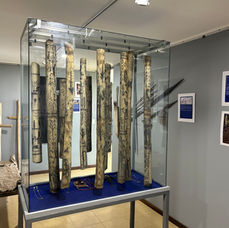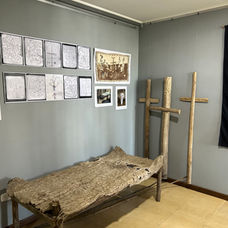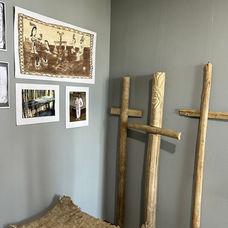
Ethnographic Research, Resources
CEDIA, Centro de Documentación & Investigación de las Artes
Mythic, shamanic, cultural, social and aesthetic aspects of indigenous cultures during a time of rapid acculturation in Costa Rica, 1986-2025.
Resource Download Page


Pedro Bejarano, Guaymí sukia, shaman with Ron Mills-Pinyas and Jorge Luis Acevedo

Ron Mills-Pinyas and Jorge Luis Acevedo
I am pleased to announce the publication of Cosmovisión y expresiones estéticas de los pueblos originarios en Costa Rica, fall 2025 by Universidad de Costa Rica Editorial, written in collaboration with my colleague of many years, the late Dr. Jorge Luis Acevedo.
In late 2025, posthumously, Dr. Acevedo was designated by the Costa Rican Dr Jorge Luis Acevedo Vargas, artist, academic, scholar, ethnographic researcher and musicologist, who recently passed away has been named by UNESCO and the Costa Rican National Committee for World Memory (Comité Nacional de Memoria del Mundo de la Comisión Costarricense de Cooperación) under cover of UNESCO, and entered in the National Registry of World Memory (Registro Nacional de Memoria del Mundo).
Spanish obituary of the life and achievements of Jorge Luis Acevedo.
Click here to download pdf files of various resources, including the entire pdf ebook (in Spanish), or the bilingual summary Culturas Indigenous Vivas en Costa Rica / Living Indigenous Culture of Costa Rica. Also click below to access various YouTube clips or see murals related to the ethnographic study. You may also view Jorge Acevedo's cultural discourse about aspects of my 1986 mural La música en los pueblos indígenas costarricenses below:
Jorge Luis Acevedo Vargas and Ronald DeWitt Mills-Pinyas established CEDIA (Centro de Documentación & Investigación de las Artes) in 1986 to study indigenous cultures, traditional knowledge and to collect categories of artifacts at risk during a period of rapid acculturation. CEDIA attends to Bribri, Terrabá, Cabécar, Maleku and Borucan and the Chorotegan cultures.
By 2025 when Jorge passed away, many of our most important informants, friends and tribal elders had passed away, and with them much traditional knowledge. Our recordings, videotapes, and field notes from years working in the field. We note the many substantive changes in meaning over time, and a distinct decrease in social-ritual functions in favor of touristic commodification. In fact, some of our recordings of past elders singing or telling traditional myths have been returned to the community for the benefit of future generations.
As Jorge and I were career academicians as well as artists, we originally envisioned CEDIA as a physical and digital center, with collaborators from various disciplines. Perhaps the full flower of that ambition may be accomplished in the future given the extensive material now offer to scholars. We realized that the rich material we were studying would ultimately require linguists, anthropologists, sociologists, religion scholars, medical specialists (given the plant medicine and shamanic healing practices) as well as art, music and dance artists and historians. We gave it a start. The intellectual challenge is to sort out and better link contemporary classifications of knowledge, and the corresponding disciplines as scholars and thinkers.
For example, indigenous shamanic "art" or "music" may in fact encompass ideas, social dynamics and philosophies that combine art, music, dance, theater, sociology, cosmology, philosophy, animistic spirituality, religion healing and linguistics--and likely more.
Another example is the ulú balsa stick, bastion. It is used in Cabecar and Bribri healing practices by high shamanic awa/jawa "medicos". The drawn balso stick is drawn with symbols that have no name, per se, but instead rhythmic chants, calling forth the spirits of the forest, and by extension healing forces that they believe surround and compose us as human beings. The stick represents the spinal column of the patient, the central post of a conical "casa sagrada, casa de dos" and a mystical link between the inframundo below and the cielo above, traversing the terrestrial plane we live on. There is more, much more, but this shows the multiple ideas that weave academic disciplines together. By looking at how music, ritual dance and object-making relate to diverse conceptions of how an animistic conception of the natural world works, in terms of different forms of shamanism and culture, we found keys and entrance points into formerly neglected aspects of Costa Rican anthropology. Jorge and I are not anthropologists, but rather artists interested in such matters who found that by attending to art and musical art forms, and addressing shamanic individuals with great respect and curiosity, valuable insights into tribal identity and forms of animism became ripe for original scholarship.
Over the years we amassed an extensive collection of art and practical items, some shamanic, part of which has been loaned to museums and exhibited in Costa Rica in a variety of venues, including the Goethe Institute, the Mueso de Oro and the Museo Nacional, and in the United States in Oregon and New Mexico. CEDIA is currently donating the bulk of the collection and electronic files to the University of Costa Rica to comprise a research archive and another museum to be centered in Turrialba, Costa Rica.
For several years, a large museum installation was at the Rainforest Lodge in Sarapiqui. Other parts of the collection have been loaned to various museums. Presently CEDIA has a well-appointed museum in a finca above Santa Ana. With the Turrialba new museum site in the near-future, CEDIA's collections and digital archive will compose valuable resources for aspiring scholars and artists.
Jorge and I have written numerous magazine articles, have performed concerts, given talks in numerous places, including in San Jose, New York and Mysore, India. Our definitive book is finally published, Antologia: Cosmovisión y expresiones estéticas de los pueblos originarios en Costa Rica, a richly-illustrated work documenting many years of field research in remote parts of Costa Rica. The in-depth study documents the current rapid acculturation of small indigenous groups using original material gleaned from dozens of field excursions into remote parts of Costa Rica working with several small indigenous tribal groups.
For me, this started as background research for a mural in 1986. Jorge's work started earlier with fieldwork with Costa Rican professor, anthropologist and sociologist Dra. Maria Eugenia Bozzoli. I hope we honor her name and ambitions with CEDIA's efforts.
Jorge was a composer, ethno-musicologist, operatic singer, esteemed professor emeritus and former Chairman of Music, later of Dean of Fine Arts at the University of Costa Rica and "in retirement", founder and Director of the School of the Integrated Arts in Santa Ana (EMAI).
He and I stared our friendship and artistic collaboration when I was embarking on a mural cycle while a Senior Fulbright Scholar at UCR on indigenous tribal groups during my first visit to Costa Rica as an exchange professor from Linfield University in 1986. Jorge was kind enough in 1986 to take me on the first of many excursions to learn something first-hand about these tribal cultures I as about to paint about. Over the years, my mural work has become more interpretive than documentary, per se, but I started this way. Jorge and I clicked as a team starting a 40 year friendship. I continued the work as a professor at Linfield University and a twice Senior Fulbright Scholar. I continued to create murals on indigenous themes over the years in San Pedro, San Ramon and in Santa Ana at EMAI (School of Integrated Arts). See above links to see more of that work. This research spans, for me, two Senior Fulbright Scholar awards (1987 and 1994), a National Endowment for the Humanities grant (1999), and mural cycles on two University of Costa Rica campuses (San Pedro in 1986, six panels and San Ramon in 1996 and at Escuela de Artes Integradas in Santa Ana, completed in 2010.
Acknowledgement:
Linfield students and colleagues, such as Dr. Jeff Peterson, sociologist, and a few others. For me, this has been a significant chapter in my life. It has enriched my approach to making my own art in subtle and profound ways. It informed my own spirituality and practice. Sustaining this friendship and collaboration in Spanish has been both challenging and satisfying, particularly now with the publication of our studies.
Thanks to all who supported our work for so many years, including our families, individuals and institutions such as Linfield University, The School of Music of the Universidad de Costa Rica (special thanks to Susan Fonseco) the Fulbright Commission and Oregon Council for the Humanities, specifically the Oregon Council for the Humanities, but most of all to the generous souls we befriended in the various tribal groups.



















































